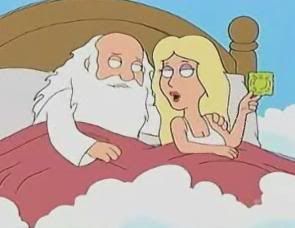
Ever since the show's creation in 1996, Comedy Central's South Park has always pushed the boundaries of decency with its graphic language and violence, its fearlessness in engaging social controversy, and its unique brand of scornful animated satire. Episodes often take on current political issues and has become quite infamous over the years for its ruthlessly parodic portrayal of world religion.

Although the episodes are usually wrapped up with a moral, show creators Trey Parker and Matt Stone are self-dubbed "equal-opportunity offenders," often ridiculing all sides of a particular issue rather than taking a definitive side. These new masters of satire expose the folly within all religious institutions, and by poking fun at everyone's individual weaknesses, show us that no one is perfect, regardless what any person or group of people believe.

South Park is set in a small mountain town near Denver, and most episodes focus on the lives of four nine-year-old boys. One (Stan) is a Christian, one (Kyle) a Jew, one a gluttonous and sadistic anti-semite (Cartman), and one (Kenny) wears a hood and is regularly resurrected from the dead.

Religious figures appear regularly in South Park. Jesus lives in the town and hosts a public access show, and other religious beings like Moses, Joseph Smith, and Moses have appeared in more than one show. Occasionally an entire episode is dedicated to the exploitation of a specific religious group. One in particular, titled "Trapped in the Closet," which attacked the Church of Scientology and celebrity members Tom Cruise and John Travolta, sparked significant controversy, and even caused Scientologist musician/voice actor Isaac Hayes to leave the show after 9 seasons as the character, "Chef."

Like most forms of controversial art and media, material from South Park is often taken out of context and used against its creators. Like notorious comedians Dave Chappelle and his successor to the Comedy Central sketch comedy throne Carlos Mencia, Parker and Stone use absurd exaggerations and stereotypes to get a rise out of people, effectively exploiting negative, potentialy disbanding issues to produce positive, unifying results. A pertinent example of South Park's satire of cults and religious fanatics can be seen in the episode entitled "Super Best Friends."

This installment featured a group of united religious deities parodic of the Super Friends, an animated TV show which featured a league of popular superheroes. In the episode, magician David Blaine forms a rapidly growing cult based around his "miracles," and wishing to learn magic tricks, the boys are tricked into joining. Soon after, Stan realizes what's happening and escapes, seeking the help of Jesus to stop Blaine from gaining too much of a following. When Jesus' miracles prove to be ineffective against David Blaine, he and Stan seek the aid of the Super Best Friends!
Although South Park approaches religion with a satirical tone, the creators are clearly not against any particular faith (apart from Scientology, and maybe Mormanism), but are against the mindless intolerance of others. For centuries, religion has caused people to divide and clash in the name of metaphysical beings. In the Super Best Friends episode, the creators portray the subjects of the most widespread world religions as close friends, clearly stating an optimistic message of world unity, regardless of religious belief.

No comments:
Post a Comment